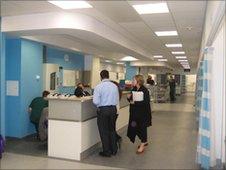First patients at Birmingham's Queen Elizabeth Hospital
- Published
Birmingham's new £545m hospital has started taking some of its first patients.
The A&E department at the new Queen Elizabeth (QE) Hospital in Edgbaston started work from 0200 BST.
Patients at the old department a mile away at Selly Oak Hospital were transferred there by ambulance.
The hospital replaces Selly Oak and the old Queen Elizabeth Hospital, which was Birmingham's last purpose-built acute unit and opened in 1937.
The new complex has 1,213 beds - about the same as the combined capacity of the old hospitals - and 30 operating theatres.
The move includes the military ward presently at Selly Oak, which cares for armed forces personnel injured in Afghanistan.
'Exemplary care'
Brigadier Christopher Parker, Commandant in Defence Medicine at Selly Oak, said: "We have a fantastic partnership with University Hospital Birmingham and its two hospitals, which give exemplary care to our casualties.
"We provide the military support and it's a really good concept of us working together, so moving into this new hospital is important for both of us."
The hospital was built under a private finance initiative and is due to be fully open by the end of 2011.

Staff get ready for the hospital's opening
Chief operating officer Kevin Bulger said planning for the A&E move had been taking place for 18 months.
Overnight, at any one time, there were due to be more than 20 ambulances ferrying people in a steady stream between Selly Oak and the new hospital.
"The main thing has been the involvement of the clinical teams of doctors and nurses to make it the safest move we can," he said.
The second stage of the move will take place in November for all inpatient beds from the QE and therapies, followed by the cardiology department in January next year.
The final stage of the move will happen in October 2011.
The new hospital will have a 100-bed critical care unit - the largest in Europe - and the largest single floor critical care unit in the world.
Each main ward has 36 beds and takes up half of one floor in each of the three towers which dominate the skyline.
Just under half of the beds - 44% - will be in single rooms and the rest in four-bed rooms, all with full en-suite facilities.
There will be sinks at the entrances to each ward to aid hand hygiene.
The hospital also boasts the very latest equipment, including diagnostic scanners, new theatre equipment and robots deployed in the pharmacy and laboratories to make drug dispensing and testing faster and safer.
It will also have a large research centre run by the University of Birmingham's medical school.
As well as 3,800 car parking spaces, the hospital will even have its own mini-ring road to improve access and reduce traffic on local roads.
A spokesman for the University Hospitals Birmingham NHS Foundation Trust said the new hospital was needed because the old ones were no longer fit for purpose.
He said: "The existing Selly Oak site was built more than 100 years ago and is just too old, the infrastructure that is there just can't take us forward.
"The QE is the same. It's a grand old hospital doing a good job but it was built in 1937."
Much of the old QE complex will be used for areas such as administration.
It is expected that the Selly Oak site, which has been a hospital since 1911, will eventually be sold for development.